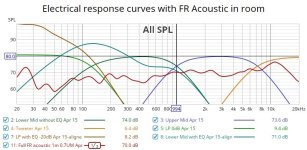A question about how to set up the crossover. In the manual for the B5, @Nelson Pass describes the following procedure:
To my admittedly limited knowledge, readings in this frequency range in the typical listening room are usually obscured by room reflections. Is there a reason that won't matter in this situation?If you have the ability to measure the response curve of the woofer / full range combination you can speed up the process. You can assume that you are looking for flat response in the crossover region which is usually somewhere in the two octaves between 75 and 300 Hz. Myself, I usually put the microphone about 1 meter from the baffle at the level between the woofer and full range drivers and measure the response in this region.
I would say that you hear the bass with the room. It is the acoustic response that counts, not the electrical response.
Re: Michael Rothacher’s simulator program:No kidding! Makes me very humble.
R1 in the simulation refers to P2 in the 6-24 crossover schematic and R2 in the sim likewise refers to P1 in the schematic.
Made clear to me with instruction from @Attila I
The goal of the measurement, I believe, is to determine whether the acoustic response of the drivers is in phase at the crossover point, with a given set of filters from the active crossover. My question is about whether this can be determined by Nelson's method if room reflections are affecting the reading.I would say that you hear the bass with the room. It is the acoustic response that counts, not the electrical response.
I've attached my latest Electrical and Acoustic measurements for 4-way dipole ASP modeled on SL's LX521 original spec, but a very crude and non-optimized variant, while still based on his XO points @ 120, 1k,& 7kHz LR4 as a starting point.
I improved my Subwoofer to Lower Mid cross by extending the Shelving Low Pass on the LM to 30-400Hz with an added Notch filter @580Hz which has
the effect of steepening the EQ as required (see SL's notes on this https://www.linkwitzlab.com/models.htm#A2).
I'm fairly happy now with the measured in room response, which remains largely within a +-6dB band (outside measurements should be better). Sound now has more pressure punch from the Lower Mid which was previously lacking.
The seven curves are;
4 electrical curves establishing the 3 crossover points (no EQ)
2 additional electrical curves showing the EQ on the Subwoofer and Lower Mid
1 Full range Acoustic measurement at 1m in-room.
added LTspice sim of SLP & Notch with DIY Front end
I improved my Subwoofer to Lower Mid cross by extending the Shelving Low Pass on the LM to 30-400Hz with an added Notch filter @580Hz which has
the effect of steepening the EQ as required (see SL's notes on this https://www.linkwitzlab.com/models.htm#A2).
I'm fairly happy now with the measured in room response, which remains largely within a +-6dB band (outside measurements should be better). Sound now has more pressure punch from the Lower Mid which was previously lacking.
The seven curves are;
4 electrical curves establishing the 3 crossover points (no EQ)
2 additional electrical curves showing the EQ on the Subwoofer and Lower Mid
1 Full range Acoustic measurement at 1m in-room.
added LTspice sim of SLP & Notch with DIY Front end
Attachments
Last edited:
Guten Tag, liebe Community, ich fange gerade erst mit dem Aufbau der Frequenzweiche an und zu den Vorteilen der Frequenzweiche gehört die Auswahl des Verstärkers, der genau zum Lautsprecherchassis passt. Und hier meine Frage: Welche beiden Verstärkertypen würden Sie für meine Hornlautsprecher mit der vom Hersteller empfohlenen Trennfrequenz von 800 Hz und für einen 15-Zoll-Treiber empfehlen? Vielen Dank
Hello, dear community, I am just starting to build the crossover and one of the advantages of the crossover is the selection of the amplifier that fits exactly to the speaker chassis. And here is my question: Which two types of amplifiers would you recommend for my horn speakers with the manufacturer's recommended crossover frequency of 800 Hz and for a 15-inch driver? Thank you very much
Hello gastitt,
you can use the lowpass only with the 6-24 AXO. Highpass and lowpass are seperated filter-sections.
Depending on what your goal is...?
Cheers
Dirk
you can use the lowpass only with the 6-24 AXO. Highpass and lowpass are seperated filter-sections.
Depending on what your goal is...?
Cheers
Dirk
Thanks Dirk. Assuming I built the entire board, would the highpass outlets need to be terminated in some way?
Greg
Greg
Hello Greg,
I would only turn the volume pot at the inputbuffer of the highpass completely down (highest resistance).
I never had the experience, that there has to be a load at the output of the unused filtersection.
Perhaps Mr. Pass can give a further advice?
Cheers
Dirk
I would only turn the volume pot at the inputbuffer of the highpass completely down (highest resistance).
I never had the experience, that there has to be a load at the output of the unused filtersection.
Perhaps Mr. Pass can give a further advice?
Cheers
Dirk
Thanks again. I have a pair of unused 22Kohm resistors that I could place across a couple of RCA plugs to maybe create reasonable loads for the highpass sections.
Sometimes nice to have a DC bleed resistor for when power is first applied, but what's
a little thump among friends....
a little thump among friends....
- Home
- Amplifiers
- Pass Labs
- DIY biamp 6-24 crossover

